
| Version | Summary | Created by | Modification | Content Size | Created at | Operation |
|---|---|---|---|---|---|---|
| 1 | Sirius Huang | -- | 3075 | 2022-11-22 01:40:54 |
Video Upload Options
A shopping cart (American English) or trolley (British English), also known by a variety of other names, is a cart supplied by a shop, especially supermarkets, for use by customers inside the shop for transport of merchandise to the checkout counter during shopping. In many cases customers can then also use the cart to transport their purchased goods to their vehicles, but some carts are designed to prevent them from leaving the shop. In many places in the United States and the United Kingdom , customers are allowed to leave the carts in designated areas within the parking lot, and store personnel will return the carts to the storage area. In many continental European premises, however, coin- (or token-) operated locking mechanisms are provided to encourage shoppers to return the carts to the correct location after use. Studies have shown that it is advisable for shoppers to sanitize the handles and basket areas prior to handling them or filling them with groceries due to high levels of bacteria that typically live on shopping carts. This is due to the carts having a high level of exposure to the skin flora of previous users.
1. Design
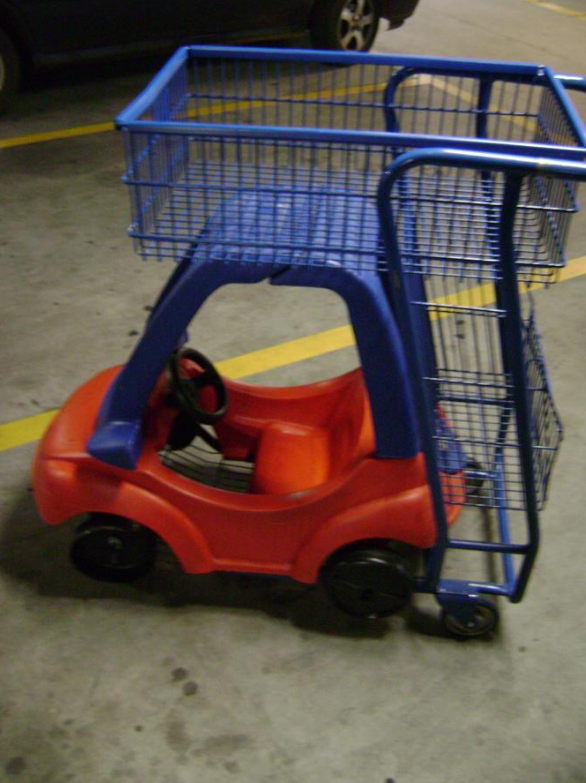
Most modern shopping carts are made of metal or a combination of metal and plastic and have been designed to nest within each other in a line to facilitate collecting and moving many at one time and also to save on storage space. The carts can come in many sizes, with larger ones able to carry a child. There are also specialized carts designed for two children, and electric mobility scooters with baskets designed for disabled customers.
In the United States, 24,000 children are injured each year in shopping carts.[1] Some stores both in the USA and internationally have child carrying carts that look like a car or van with a seat where a child can sit equipped with a steering wheel and sometimes a horn. Such "Car-Carts" may offer protection and convenience by keeping the child restrained, lower to the ground, protected from falling items, and amused.
Shopping carts are usually fitted with four wheels, however if any one wheel jams the cart can become difficult to handle. Most carts in the United States have swivel wheels at the front, while the rear wheels are fixed in orientation, while in Europe it is more common to have four swivel wheels. This difference in design correlates with smaller retail premises in Europe.
An alternative to the shopping cart is a small hand-held shopping basket. A customer may prefer a basket for a small amount of merchandise. Small shops, where carts would be impractical, often supply only baskets, or may offer a small cart which uses an inserted shopping basket within the frame of the cart to provide either choice to a customer.
2. History
2.1. Development of First Shopping Cart by Sylvan Goldman
One of the first shopping carts was introduced on June 4, 1937, the invention of Sylvan Goldman, owner of the Humpty Dumpty supermarket chain in Oklahoma. One night, in 1936, Goldman sat in his office wondering how customers might move more groceries.[2] He found a wooden folding chair and put a basket on the seat and wheels on the legs. Goldman and one of his employees, a mechanic named Fred Young, began tinkering. Their first shopping cart was a metal frame that held two wire baskets. Since they were inspired by the folding chair, Goldman called his carts "folding basket carriers". Another mechanic, Arthur Kosted, developed a method to mass-produce the carts by inventing an assembly line capable of forming and welding the wire. The cart was awarded patent number 2,196,914 on April 9, 1940 (Filing date: March 14, 1938), titled, "Folding Basket Carriage for Self-Service Stores". They advertised the invention as part of a new “No Basket Carrying Plan." Goldman had already pioneered self-serve stores and carts were part of the self-serve retail concept.[3]
The invention did not catch on immediately. Men found them effeminate; women found them suggestive of a baby carriage. "I've pushed my last baby," an offended woman informed Goldman. After hiring several male and female models to push his new invention around his store and demonstrate their utility, as well as greeters to explain their use, shopping carts became extremely popular and Goldman became a multimillionaire. In urban areas like New York City , where transporting groceries home from the store's parking lot is more likely to involve walking and/or a trip by public transportation than a car ride, privately owned carts resembling Goldman's design are still popular. Instead of baskets, these carts are built to hold the paper bags dispensed by the grocery store.
Another shopping cart innovator was Orla Watson,[4] who invented the swinging rear door to allow for "nesting" in 1946.[5][6][7]
Goldman continued to make modifications to his original design, but advice from his trusted business partners Fred Taylor, a grocery store owner,[8] and George O'Donnell, a grocery store refrigeration salesman, and the incorporation of Watson's swinging door yielded the familiar nesting cart that we see today (albeit the original telescope cart had two baskets rather than one).[9] Goldman patented a similar version of the cart which he called the "Nest-Kart" in 1948, over one year after Watson filed for his patent.[8] The Nest-Kart incorporated the same nesting mechanism present on the shopping carts designed by Watson, and an interference investigation was ordered by Telescope Carts, Inc. alleging infringement of the patent in 1948.[8] After a protracted legal battle, Goldman ultimately recognized Watson’s invention and paid one dollar in damages for counterfeit, in exchange for which Watson granted Goldman an exclusive operating license (apart from the three licenses that had already been granted).[8]
In 1909, Bessie DeCamp invented a seat belt for chairs, go-carts or carriages.[10] This was well before shopping carts with child seating areas were invented. Goldman introduced a child seating area on shopping carts in 1947.[11][12] For whatever reason, it wasn't until 1967 that seat belts for shopping carts were introduced by David Allen. It was high tech for the time, because it was a retractable seat belt.[13]
2.2. Development of Nesting Carts by Orla Watson
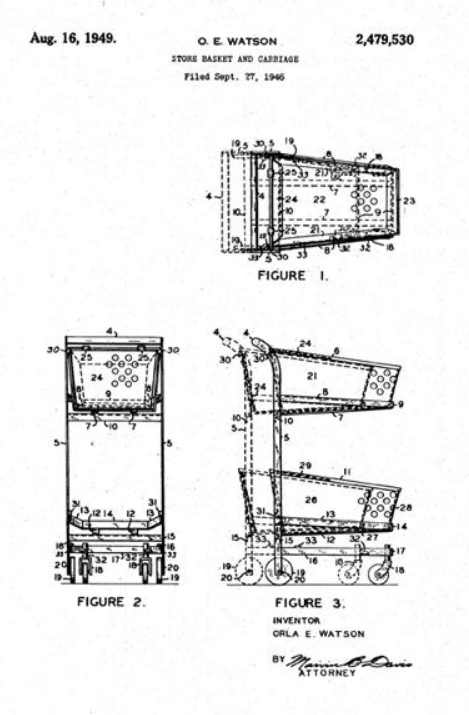
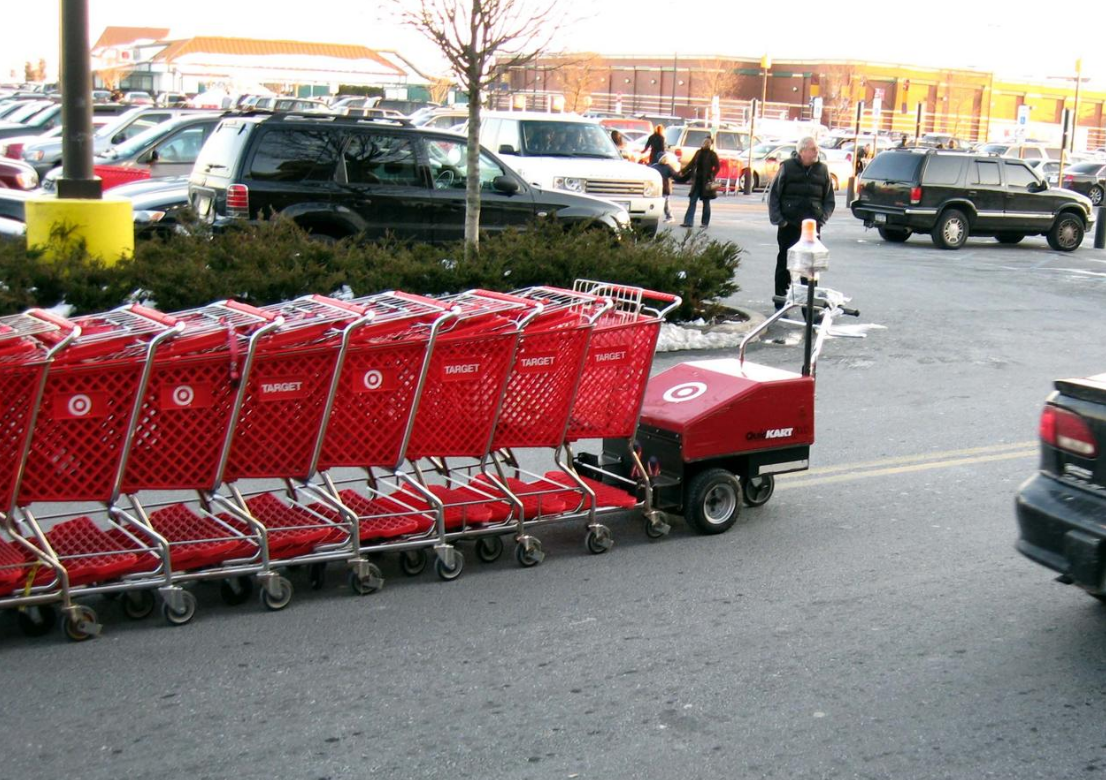
In 1946, Orla Watson devised a system for a telescoping (i.e., "nesting") shopping cart which did not require assembly or disassembly of its parts before and after use like Goldman's cart; Goldman's design up until this point required that the cart be unfolded much like a folding chair.[8] This cart could be fitted into another cart for compact storage via a swinging one-way rear door. The swinging rear door formed the basis of the patent claim, and was a major innovation in the evolution of the modern shopping cart. Watson applied for a patent on his shopping cart invention in 1946, but Goldman contested it and filed an application for a similar patent with the swinging door feature on a shopping cart with only one basket in 1948 which Goldman named the "Nest-Kart". After considerable litigation and allegations of patent infringement, Goldman relinquished his rights to the patent in 1949 to Watson and his company, Telescope Carts, Inc. realizing that the swinging rear door feature was the key to Watson's patent. Watson was awarded patent #2,479,530 on August 16, 1949.[14] In exchange, Goldman was granted an exclusive licensing right in addition to the three other licenses previously granted; Telescope Carts, Inc. continued to receive royalties for each cart produced by Goldman's company that incorporated the "nesting" design. This included any shopping cart utilizing his hinged rear door, including the familiar single basket "nesting" designs similar to those used in the present.[15]
Owing to its overwhelming success, many different manufacturers desired to produce shopping carts with the rear swinging door feature but were denied due to the exclusive license issued to Goldman. The federal government filed a lawsuit against Telescope Carts, Inc. in 1950 alleging the exclusive license granted to Goldman was invalid, and a Consent Decree was entered into where Telescope Carts, Inc. agreed to offer the same license to any manufacturer. Orla Watson and Telescope Carts, Inc. licensed their telescoping shopping cart design to several manufacturers throughout the 1950s and 1960s until the patent expired.
2.3. New Developments
In 2012, a driverless shopping cart was made by Chaotic Moon Labs.[16] The device, called "Project Sk8" or "Smarter Cart" was basically a cart fitted with Windows Kinect (to detect obstacles), and an electric drivetrain, and used in conjunction with a Windows 8 tablet. For smaller stores, shopping baskets with wheels can be used either as a large basket or a small cart. These carts are designed for indoor use only
3. Retail Store Acceptance
Past studies determined that retailers who did not offer shopping carts such as Sears suffered lower sales in comparison with retailers who did use shopping carts.[17] Subsequent to the introduction of shopping carts and centralized checkout lines at Sears stores, the company noticed a correlating increase in sales.[18]
In 2004 British supermarket chain Tesco, trialed shopping carts with user-adjustable wheel resistance, heart rate monitoring and calorie counting hardware in an effort to raise awareness of health issues. The cart's introduction coincided with Tesco's sponsorship of the cancer awareness Race for Life.[19][20]
Also in 2004, shopping carts were identified as a source of pathogens and became a major public health concern. This was primarily due to the media spotlight on a Japanese research study revealing large amounts of bacteria on shopping carts.[21][22] Those findings were later backed by a University of Arizona study in 2007.[23]
In 2009 researchers developed prototypes of computerized context aware shopping carts by attaching tablet computers to ordinary carts. Initial field trials showed that the prototype's context awareness provided an opportunity for enhancing and altering the shopping experience.[24]
Some retailers, such as Target, have begun using carts fully made of recycled plastic with the only metal part being the wheel axles, drawing away from the established metal cart design. Target's cart has won design awards for its improved casters, interchangeable plastic parts to simplify repairs, and handles that improve maneuverability.[25] Other cart designs also incorporate additional features such as a cupholder for cold or hot drinks or a bouquet of flowers, along with other features such as a secure shelf for a tablet computer or mobile phone to allow the use of mobile coupons and circulars, or as seen in an all-plastic design created for the Wisconsin-based Festival Foods and also used by Whole Foods Market by Bemis Manufacturing Company, all of these features, along with extra rungs on the side rail designed to attach plastic bags or carry handles for beverages. Smaller half-sized carts for smaller shopping trips have also become common.[26]
4. Deposits
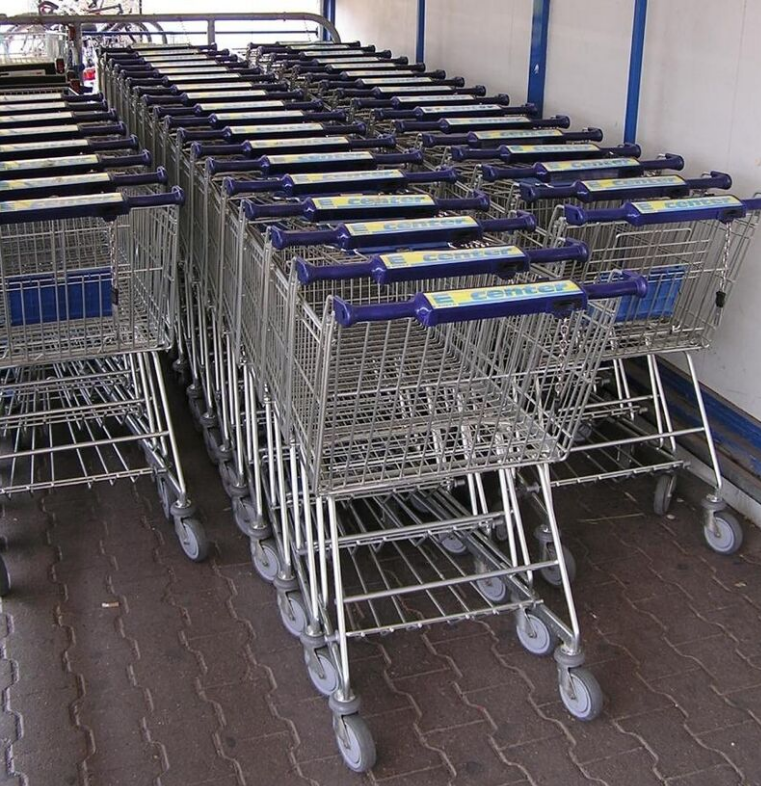
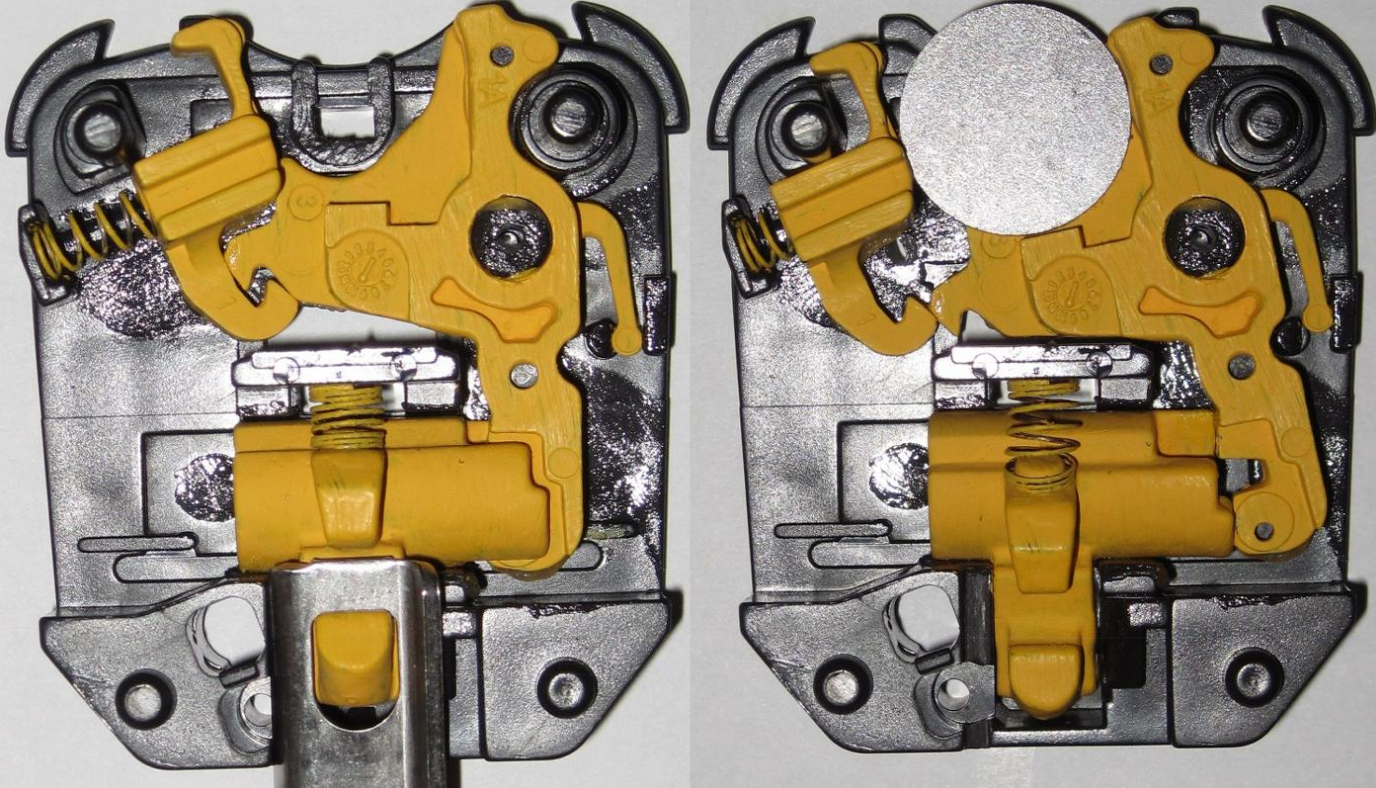
In many countries, the customer has to pay a small deposit by inserting a coin, token or card, which is returned if and when the customer returns the cart to a designated cart parking point. One motivation behind the deposit system is to reduce the expense of employees having to gather carts that are not returned, and to avoid damage done by runaway carts. Trolleys that are not returned may be returned voluntarily by a pedestrian, with the deposit coin acting as a reward.
Although almost ubiquitous in continental Europe, the deposit system is less common in the United Kingdom and Canada and has not been widely adopted in the United States, with the exception of some chains like Aldi, which require a $0.25 deposit. Other stores such as Costco and ShopRite also use the coin deposit system, but it is not used at all of their locations.
In Australia, deposit systems are common in some local government areas as they have been made compulsory by local law. Usually, all ALDI stores, and most Coles and Woolworths stores will have a lock mechanism on their carts which requires a $1 or $2 coin to unlock.
The deposit varies, but usually coins of higher value, such as €1, £1, or $1 are used. While the deposit systems usually are designed to accommodate a certain size of domestic coin, foreign coins, former currencies (like German D-Marks), or even appropriately folded pieces of cardboard can be used to unlock the carts as well. Cart collectors are also usually provided with a special key which they can use to unlock the carts from the cart bay and get the key back.
Some retailers sell "tokens" as an alternative to coins, often for charity. Merchandising companies also offer branded shopping tokens as a product.
5. Theft Prevention
Shopping cart theft can be a costly problem with stores that use them. The carts, which typically cost between $75 and $150 each with some models being $300–400, are removed by people for various purposes. To prevent costly theft, estimated at $800 million worldwide per annum, stores use various security systems as discussed below.[27]
5.1. Cart Retrieval Service
Most retailers in North America utilize a cart retrieval service, which collects carts found off the store's premises and returns them to the store for a fee. The primary strength of this system is the ability of pedestrian customers to take purchases home and allow retailers to recapture abandoned carts in a timely manner at a fraction of the cost of a replacement cart. It also allows retailers to maintain their cart inventories without an expensive capital outlay.[28] A drawback of this method is that it is reactive instead of proactively preventing the carts from leaving a parking lot.[27]
5.2. Electronic and Magnetic
Electronic systems are sometimes used by retailers. Each shopping cart is fitted with an electronic locking wheel clamp, or 'boot'. US Patent No. 5598144A. A transmitter with a thin wire is placed around the perimeter of the parking lot, and the boot locks when the cart leaves the designated area. Store personnel must then deactivate the lock with a handheld remote to return the cart to stock. Often a line is painted in front of the broadcast range to warn customers that their cart will stop when rolled past the line. However, these systems are very expensive to install and although helpful are not foolproof. The wheels can be lifted over the electronic barrier and/or pushed hard enough that the locks break.[27][29] There are also safety concerns if the person pushing the trolley is running, and also if the trolley doesn't lock and is taken onto a road, locking due to magnetic materials under the road. Some cities have required retailers to install locking wheel systems on their shopping carts. In some cases, electronic systems companies have encouraged passage of such laws to create a captive audience of potential customers.[30]
5.3. Physical
A low-tech form of theft prevention utilizes a physical impediment, such as vertical posts at the store entrance to keep carts from being taken into the parking lot. This method also impedes physically disabled customers, which may be illegal in many jurisdictions. For example, in the United States of America it is a violation of the Americans with Disabilities Act.[29]
Another method is to mount a pole taller than the entrance, onto the shopping cart, so that the pole will block exit of the cart. However, this method requires that the store aisles be higher than the pole, including lights, piping, any overhead signage and fixtures. It also prevents customers from carting their purchases to their cars in the store's carts. Many customers learn to bring their own folding or otherwise collapsible cart with them, which they can usually hang on the store's cart while shopping.
A further system is to use a cattle grid style system. All pedestrian exits have specially designed flooring tiles which, along with specially designed wheels on the cart, will immobilize the cart as they roll onto them. Like the magnetic systems, this can easily be overcome by lifting the cart over the tiles.
Some retailers, including the Aldi chain of supermarkets, use a system where each cart has a lock mounted on the handle, connecting it to the cart in front of it when nested together, or to a chain mounted on a cart collection corral. The lock releases when a suitable coin or token is inserted, and the user gets their coin or token ejected back out of the lock when the cart is reattached to another trolley. This encourages shoppers to bring their carts back, solving both theft and the issue of carts being left around parking lots. The system is slightly flawed, however, in that carts can be attached to each other away from the corral and retrieve your tokens from all but the front-most cart.
6. Name
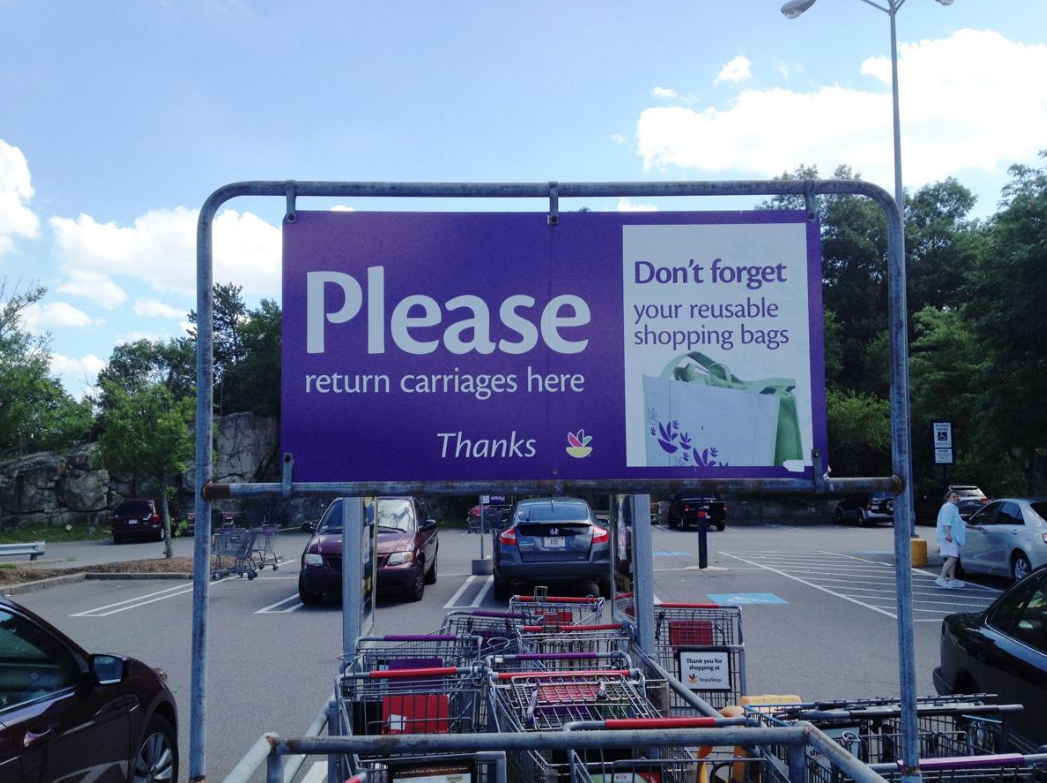
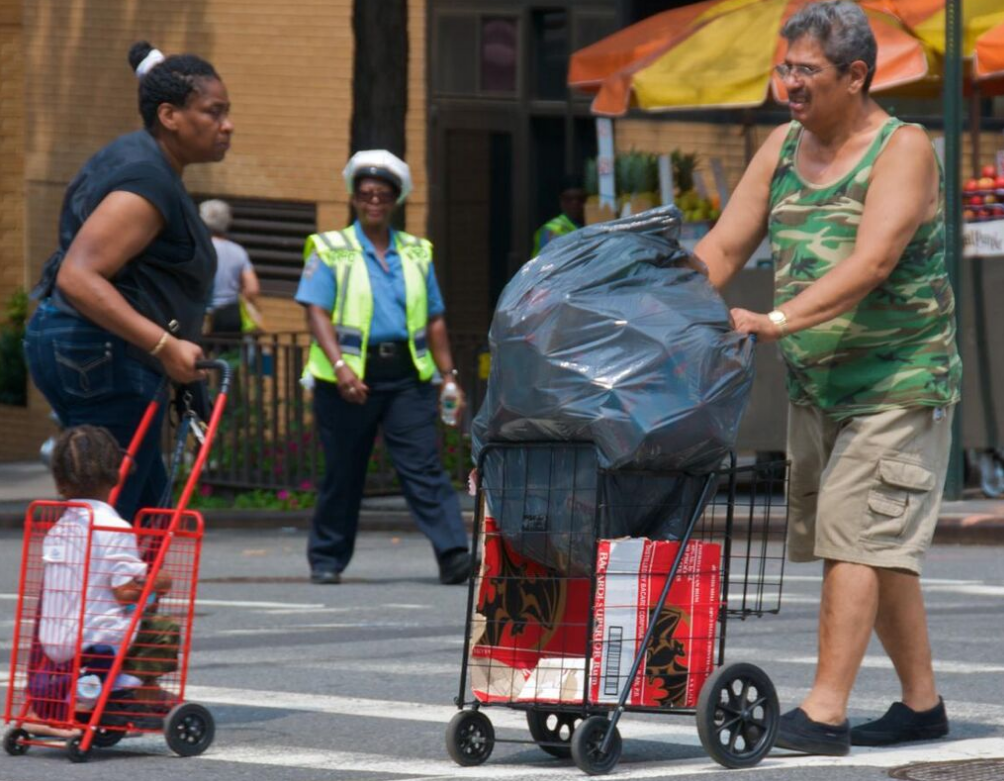
The names of a shopping cart vary by region. The following names are region specific names for shopping carts. Many of these names may be used alone or in descriptive phrases such as grocery ____, shopping ____, or supermarket _____ :[31]
- cart, or basket – The United States and Canada .
- buggy – Used by some in Southeast Michigan, the Southern United States and parts of Canada
- trolley – the United Kingdom , Ireland, Australia , New Zealand, Malaysia, South Africa and some regions of Canada .
- carriage – Used by some in the New England region of the United States.
- trundler – New Zealand.
- barrae or coohudder - Some places in Scotland.
- bascart – various regions.
- wagon – New York, Hawaii.
7. For People with a Disability
Special electronic shopping carts are provided by many retailers for the elderly or people with a disability. These are essentially electric wheelchairs with an attached basket. They allow customers to navigate around the store and collect items.
Manually powered carts are also available specifically designed for use by wheelchair users.[32][33] A still to be implemented aid for people with disabilities is the addition of a guide wheel at the center of rotation of a cart with four caster wheels. In order to allow the nesting of carts to be unhindered this guide wheel is attached to the front of the cart with a piece of spring steel which bends under the cart's weight.[34]
References
- Gary A. Smith, MD, DrPH (2006). "Shopping Cart–Related Injuries to Children". Pediatrics. American Academy of Pediatrics. http://pediatrics.aappublications.org/content/118/2/e540.abstract. Retrieved June 20, 2012.
- "Sylvan Goldman: Fascinating facts about Sylvan Goldman inventor of the shopping cart in 1937". The Great Idea Finder. The Great Idea Finder. April 24, 2007. http://www.ideafinder.com/history/inventors/goldman.htm. Retrieved June 20, 2012.
- Crockett, Zachary. "How a Basket on Wheels Revolutionized Grocery Shopping". http://priceonomics.com/how-a-basket-on-wheels-revolutionized-grocery/. Retrieved March 8, 2016.
- Orla Watson Invented the Grocery Cart with a Basket. November 16, 2003. American Profile. http://americanprofile.com/articles/orla-watson-invented-the-grocery-cart-with-a-basket/
- Terry P. Wilson, The Cart that Changed the World: The Career of Sylvan N. Goldman (University of Oklahoma Press, 1978). ISBN:978-0-8061-1496-5
- Catherine Grandclément, "Wheeling One's Groceries Around the Store: The Invention of the Shopping Cart, 1936-1953", in Warren Belasco and Roger Horowitz (eds.), Food Chains: From Farmyard to Shopping Cart (University of Pennsylvania Press, 2008), pp. 233-251. ISBN:978-0-8122-4128-0
- Ted Morgan, On Becoming American: A Celebration of What it Means and How it Feels (Boston: Houghton Mifflin, 1978, pp. 45-6). ISBN:978-0-395-26283-2
- Catherine Grandclément (2006). Wheeling food products around the store… and away: the invention of the shopping cart, 1936-1953 . CSI Working Papers Series. http://www.csi.ensmp.fr/working-papers/WP/WP_CSI_006.pdf
- Smithsonian Snapshot: Telescoping Shopping Cart, c. 1949. Newswise.com. http://www.newswise.com/articles/smithsonian-snapshot-telescoping-shopping-cart-c-1949
- Child's-chair safety device - Bessie DeCamp - patent #944,020
- "Unarco--Cart History". http://www.unarco.com/carthistory.html. Retrieved March 31, 2016.
- Phil Ament. "Inventor Sylvan Goldman Biography". Ideafinder.com. http://www.ideafinder.com/history/inventors/goldman.htm. Retrieved March 31, 2016.
- Safety retaining belt for shopping carts – David L. Allen – patent #3,550,136
- "ArchPatent". ArchPatent. http://www.archpatent.com/applicants/%220%20E.%20WATSON%202%204%207%209%205%203%200%20STORE%20BASKET%20AND%20CARRIAGE%20Filed%20September%201946%201%22. Retrieved April 7, 2013.
- Jeanne Sklar. "Technology, Invention, and Innovation collections". Amhistory.si.edu. http://amhistory.si.edu/archives/d8739.htm. Retrieved April 7, 2013.
- "Microsoft Kinect Games Grocery Shopping at Texas Whole Foods". WIRED. February 27, 2012. https://www.wired.com/2012/02/shoppingcart/. Retrieved March 31, 2016.
- Assortment (referencing a study by Britt Beamer of America's Research Group) Influence Of The Shopping Cart, Retrieved on May 23, 2011. https://web.archive.org/web/20011031161554/http://www.americasresearchgroup.com/britt.html
- Dr. Steve Vitucci, Texas A&M University – Central Texas Sears update case notes, Retrieved on May 23, 2011. http://www.tarleton.edu/~svitucci/Cases/Sears/SEARS%20UPDATE%20case%20notes.doc
- "Trolley offers supermarket workout". BBC News (BBC). April 28, 2004. http://news.bbc.co.uk/2/hi/3665777.stm. Retrieved June 20, 2012.
- Elana Bowman. "Trim Trolley Takes Off The Weight While You Grocery Shop". Inventor Spot. Aha Cafe LLC.. http://inventorspot.com/articles/trim_trolley_takes_weight_while__7543. Retrieved June 20, 2012.
- Loeb, Heather (April 21, 2015). "Eliminate Germs from Your Life". Menshealth.com. http://www.menshealth.com/health/eliminate-germs-your-life. Retrieved April 4, 2016.
- African Journal of Microbiology Research Vol. 5(23), pp. 3998-4003, October 23, 2011
- Vincent Sobotka (March 14, 2011.) Study: E.coli contamination found on half of shopping carts. Digital Journal. http://digitaljournal.com/article/304424
- Black, D., Clemmensen, N. J., and Skov, M. B. (2009) Shopping in the Real World: Interacting with a Context-Aware Shopping Trolley, Proc. of Mobile Interaction with the Real World. Shopping in the Real World: Interacting with a Context-Aware Shopping Trolley http://citeseerx.ist.psu.edu/viewdoc/download?doi=10.1.1.149.7239&rep=rep1&type=pdf
- Cook, Kim (September 7, 2011). "Shopping cart advances just keep rolling along". MSNBC. http://www.msnbc.msn.com/id/44431406/ns/business-retail/. Retrieved September 8, 2011.
- Jansen, Kerri (June 14, 2016). "Bemis develops line of all-plastic shopping carts". Plastics News. http://www.plasticsnews.com/article/20160614/NEWS/160619934/bemis-develops-line-of-all-plastic-sh_2. Retrieved October 31, 2016.
- Wilkinson, Kelly; Learmonth, Michael (June 3, 1999). "Wheels of Fortune". Metroactive. http://www.metroactive.com/papers/metro/06.03.99/shoppingcarts-9922.html. Retrieved May 5, 2009.
- Montague, Julian. "The Stray Shopping Cart Project". Web Site. The Stray Shopping Cart Project. http://www.strayshoppingcart.com/shopping_cart/1_introduction.htm. Retrieved September 8, 2011.
- William, Dara Akiko (April 20, 1999). "Corralling Carts: Anti-Theft Device Keeps Shopping Baskets In Their Place". Los Angeles Daily News (Gale Group). http://www.thefreelibrary.com/CORRALING+CARTS%3B+ANTI-THEFT+DEVICE+KEEPS+SHOPPING+BASKETS+IN+THEIR...-a083608953. Retrieved May 5, 2009.
- Elmahrek, Adam (February 24, 2011). "Santa Ana Shopping Cart Law Shows Extent of Mayor's Business Dealings". Voice of OC. http://www.voiceofoc.org/oc_central/article_cbb69e46-3fef-11e0-89d8-001cc4c002e0.html. Retrieved September 8, 2011.
- "The Cambridge Online Survey of World Englishes". Tekstlab.uio.no. http://www.tekstlab.uio.no/cambridge_survey/maps/69. Retrieved March 31, 2016.
- "Trolley for use with a wheelchair, United States Patent 4555124". FPO. FreePatentsOnline.com. http://www.freepatentsonline.com/4555124.html. Retrieved June 20, 2012.
- "Zinc Plated Clear Coated Wire Basket Shopping Cart/Trolleys with multiple capacities". QHDC Australia. QHDC Australia PTY LTD. http://www.qhdc.com.au/category/2-shopping-trolleys-accessories. Retrieved July 29, 2014.
- "Guide wheel assembly for carts, United States Patent 7198279". FPO. FreePatentsOnline.com. http://www.freepatentsonline.com/7198279.html. Retrieved June 20, 2012.




